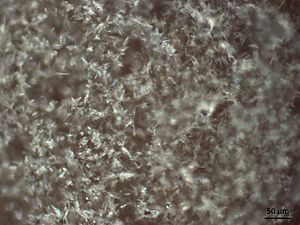Chocolate bloom facts for kids

Have you ever seen a white, dusty coating on your chocolate bar? That's called chocolate bloom. It's a common thing that happens to chocolate. There are two main types: fat bloom and sugar bloom. Fat bloom happens when the fats in the chocolate change. Sugar bloom happens when moisture affects the sugar. Even though it might not look great, chocolate with bloom is usually still safe to eat! It just might feel a bit different or not look as shiny. You can sometimes fix bloomed chocolate by melting it and letting it cool again.
What is Fat Bloom?
Fat bloom happens when the cocoa butter (a type of fat in chocolate) separates from the other parts of the chocolate. This usually happens when chocolate is stored for a long time or if it gets old.
Think of it like this: cocoa butter can exist in different forms, like ice can be solid or melt into water. In chocolate, we want the cocoa butter to be in a very stable, solid form. If the chocolate isn't made perfectly, or if it gets too warm, the cocoa butter can change into a less stable form. These less stable fats can then move to the surface of the chocolate, making it look white and dull.
Changes in temperature can make fat bloom happen faster. If chocolate gets warm and then cools down many times, it's more likely to get fat bloom. This is why it's important to store chocolate in a cool, steady place.
What is Sugar Bloom?
While fat bloom is common, sugar bloom also happens. Sometimes it's hard to tell the difference just by looking!
Here's how to tell them apart:
- Feel it: If you touch sugar bloom, it feels dry and rough. It won't melt when you touch it. Fat bloom, on the other hand, feels a bit slick or greasy and might melt a little from your body heat.
- Add water: Put a tiny drop of water on the bloom. If it's fat bloom, the water will just sit there like a bead. If it's sugar bloom, the water will quickly spread out and dissolve the tiny sugar bits on the surface.
- Warm it up: Gently warm the chocolate surface, maybe with a hairdryer on a low setting. If it's fat bloom, the white coating will melt away. If it's sugar bloom, it will stay the same.
Sugar bloom is caused by moisture. If water gets on the chocolate, like from condensation (when warm, moist air hits a cold surface), the sugar on the chocolate's surface can absorb this water and dissolve. When the water then dries up, the sugar forms new, larger crystals. These crystals create that dusty, white layer you see.
Sugar bloom can happen if:
- Chocolate is stored in a damp or humid place.
- Chocolate gets cold and then moves into a warm, humid room, causing "dew" to form on it.
- The chocolate has ingredients that easily absorb moisture.
- Chocolate-covered candies are stored in very warm places, and moisture from the candy's center gets trapped in the wrapper.
How to Prevent Sugar Bloom
You can help prevent sugar bloom by keeping chocolate products at a good, steady storage temperature. It's best to avoid big changes in temperature and keep chocolate away from humid places.
See also
 In Spanish: Floración del chocolate para niños
In Spanish: Floración del chocolate para niños



